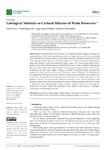Mostrar o rexistro simple do ítem
Geological Materials as Cultural Markers of Water Resources
| dc.contributor.author | Alves, Carlos | |
| dc.contributor.author | Figueiredo, Carlos Alberto Machado | |
| dc.contributor.author | Sanjurjo-Sánchez, Jorge | |
| dc.contributor.author | Hernández Santomé, Ana Cristina | |
| dc.date.accessioned | 2021-05-24T15:03:50Z | |
| dc.date.available | 2021-05-24T15:03:50Z | |
| dc.date.issued | 2020-12-01 | |
| dc.identifier.citation | Alves, C.; Figueiredo, C.; Sanjurjo-Sánchez, J.; Hernández, A.C. Geological Materials as Cultural Markers of Water Resources. Environ. Sci. Proc. 2021, 5, 8. https://doi.org/10.3390/IECG2020-08735 | es_ES |
| dc.identifier.issn | 2673-4931 | |
| dc.identifier.uri | http://hdl.handle.net/2183/27992 | |
| dc.description.abstract | [Abstract] Water has always been a critical resource for humans and climate change could aggravate supply problems. In this context, groundwater could be an important reservoir of water, especially given the dispersion of places where it can be obtained and the widespread occurrence of surface marks (springs). Historically, places where groundwater is available have been marked by humans using built structures, with stone materials having a major role. These cultural objects tend to become a part of the collective memory and the historical record (when available) and frequently they stay on the original site along time (hence “marking a spot” for groundwater). However, the development of major water supply structures, especially in the 20th century, promoted the negligence of these ancient water sources. We present a general defense of the importance of recording and preserving cultural stone related to water sources, preferably in the original sites. Conservation of groundwater-related structures could help in the future exploration of this geological resource and converge with historical information on the fountains’ discharge, with geological studies of the terrains and geochemical features of the groundwaters involved, in order to characterize the hydrogeological systems and their potential future use (including the preservation of water quality and properties). These studies could promote a synergetic conservation of both heritage and water. | es_ES |
| dc.description.sponsorship | Portugal. Fundação para a Ciência e a Tecnologia; UIDB/04509/2020 | es_ES |
| dc.description.sponsorship | Portugal. Fundação para a Ciência e a Tecnologia; UIDB/04028/2020 | es_ES |
| dc.description.sponsorship | Xunta de Galicia; ED431B 2018/47 | es_ES |
| dc.description.sponsorship | Xunta de Galicia; R2017/008 | es_ES |
| dc.description.sponsorship | The Lab2PT-Landscapes, Heritage and Territory laboratory—UIDB/04509/2020 is supported by the Portuguese FCT—“Fundação para a Ciência e a Tecnologia”. The authors also gratefully acknowledge the support of the CERENA (funded by a strategic project of the FCT UIDB/04028/2020) and the LAMPIST of the DECivil, Instituto Superior Técnico, University of Lisbon, Portugal. The University Institute of Geology of the University of A Coruña (Spain) receives support from the Xunta de Galicia from the program “Consolidación y estructuración de unidades de investigación competitivas: Grupos de potencial de crecimiento” (ED431B 2018/47) and Redes de investigación (R2017/008). We also thank the IACOBUS Program from the European Strategic Group of Territorial Cooperation Galicia/North of Portugal for support for the last author | |
| dc.description.sponsorship | The Lab2PT-Landscapes, Heritage and Territory laboratory—UIDB/04509/2020 is supported by the Portuguese FCT—“Fundação para a Ciência e a Tecnologia”. The authors also gratefully acknowledge the support of the CERENA (funded by a strategic project of the FCT UIDB/04028/2020) and the LAMPIST of the DECivil, Instituto Superior Técnico, University of Lisbon, Portugal. The University Institute of Geology of the University of A Coruña (Spain) receives support from the Xunta de Galicia from the program “Consolidación y estructuración de unidades de investigación competitivas: Grupos de potencial de crecimiento” (ED431B 2018/47) and Redes de investigación (R2017/008). We also thank the IACOBUS Program from the European Strategic Group of Territorial Cooperation Galicia/North of Portugal for support for the last author | |
| dc.language.iso | eng | es_ES |
| dc.publisher | MDPI | es_ES |
| dc.relation.uri | https://doi.org/10.3390/IECG2020-08735 | es_ES |
| dc.rights | Atribución 4.0 Internacional | es_ES |
| dc.rights.uri | http://creativecommons.org/licenses/by/4.0/ | * |
| dc.subject | Groundwater | es_ES |
| dc.subject | Water supply | es_ES |
| dc.subject | Climate change | es_ES |
| dc.subject | Conservation of cultural stone | es_ES |
| dc.subject | Historical and archaeological sources of information | es_ES |
| dc.subject | Urban planning | es_ES |
| dc.subject | Synergetic conservation | es_ES |
| dc.title | Geological Materials as Cultural Markers of Water Resources | es_ES |
| dc.type | info:eu-repo/semantics/article | es_ES |
| dc.rights.access | info:eu-repo/semantics/openAccess | es_ES |
| UDC.journalTitle | Environmental Sciences Proceedings | es_ES |
| UDC.volume | 5 | es_ES |
| UDC.issue | 1 | es_ES |
| UDC.startPage | 8 | es_ES |
Ficheiros no ítem
Este ítem aparece na(s) seguinte(s) colección(s)
-
IUX-CULXEO - Artigos [64]






